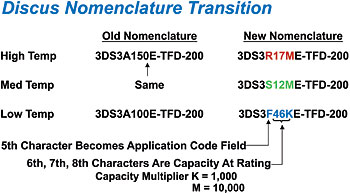
"Using a horsepower range for the compressor doesn't tell you what you want to know," said Jim Mozer, marketing director for Copeland Refrigeration, part of Emerson Climate Technologies, announcing the change for the company's Discus® line of refrigeration compressors. "A new nomenclature allows us to put the compressor's capacity and application in the name, so it will make the model easier to spec and give designers more options."
Discus (disk valve) semi-hermetic reciprocating compressors make up the predominant technology used in supermarket refrigeration in the United States, Emerson officials said.
Rajan Rajaendran, director of refrigeration application engineering, said the horsepower terminology on the air conditioning side is meaningful, because 1 hp roughly equals 12,000 Btu of cooling. On the refrigeration side, "that rule of thumb breaks down when we go to medium- and low-temperature applications.
"Typically, customers specify load at certain evaporating temperatures," he said. "Compressors are then selected with capacities that match the load, with some excess safety capacity thrown into the calculation."

For example, under the previous nomenclature, a 15-hp, high-temperature Discus compressor would be indicated as 3DS3A 150E-TFC-200; the "15" in the midst of the sequence was the horsepower. Under the new nomenclature, the same compressor will appear with the label 3DS3R 17ME-TFC - 200. The fifth character in the sequence (in this example, "R") denotes high temperature. If the fifth character were an "S," it would denote medium temperature. "F" would be low temperature.
The "17M" identifies the compressor's capacity by identifying the numeric value and multiplier, with "K" equal to 1,000 and "M" equal to 10,000. For this example, "17M" identifies 17 times 10,000, or 170,000 Btu per hour of capacity at the compressor's rated condition.
Kurt Knapke, marketing manager for supermarkets and industrial applications, said the change affects nomenclature only on Discus compressors. The actual compressor will remain the same. Therefore, there will be no changes to installation, servicing, and aftermarket replacements for these compressors, he said.
Discus compressors with the new nomenclature will range from 16K (16,000 Btuh) to 67M (670,000 Btuh) of capacity.
Knapke said that compressor models will be available in both nomenclatures through Oct. 1, 2006. After Oct. 1, the compressors will only be offered with the new nomenclature. Emerson Websites and wholesalers will also be able to assist users of the compressors in the transition.
It was noted that the approach is already been used with other compressor products, such as Copeland scroll compressors.
Knapke said the move to capacity-based nomenclature is part of a range of efforts being made to improve the Discus product line. He said these efforts address the top concerns of supermarket executives by reducing initial applied costs, consumption, food loss, maintenance costs, and improving overall system operations.
For more information, visit www.copeland-corp.com.
Publication date: 04/03/2006


Report Abusive Comment